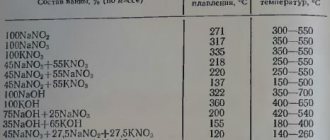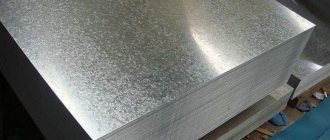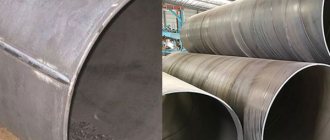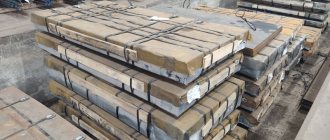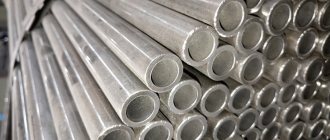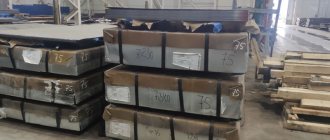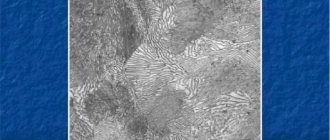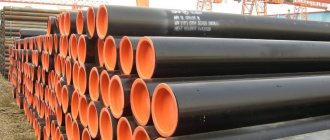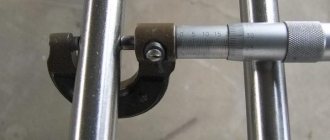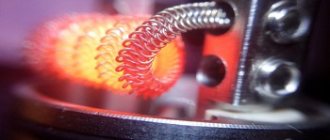Chemical composition of steel 45
In many ways, performance and other qualities are determined by the chemical composition. This is due to the fact that some elements can significantly increase strength, while others increase fragility. The chemical composition of steel 45 is characterized by the presence of the following elements:
- The main chemical elements of St 45 are iron and carbon. The concentration of the second element largely determines how strong and hard the product is. Established standards specify that the carbon concentration should be from 0.42 to 0.5%. At the same time, the metal composition is about 97%.
- The composition includes a relatively small amount of alloying elements. The main ones can be called magnesium and silicon. Their concentration rate is more than 0.1%.
- The concentration of other elements is maintained within a certain range. For example, GOST defines a small amount of sulfur and phosphorus, since these elements lead to deterioration in performance.
Pipes St45
The carbon content, like many other elements, is maintained within a certain range. This element largely determines the main characteristics of the resulting products; too high a concentration can lead to surface hardness and structure fragility.
Alloy marking
Structural high-quality carbon steels are marked according to the standard with a two-digit number: steel 05, 08...80, 85, which indicates the average value of carbon content expressed in hundredths of a percent. Three digits of the marking indicate that the alloy contains more than 1% carbon, the letter L indicates the absence of alloying - 45l, the letter St indicates its ordinary quality - St5.
The metallurgical industry produces standard steel grades from 05kp to 60, the average carbon index of which is 0.05-0.60 percent, according to the marking. Decoding steel grade 45 (French analogue of C45) shows a content of 0.45% C.
Material properties
The mechanical properties of steel 45 determine the wide distribution of this metal. The carbon concentration is 0.45%, other impurities are extremely minor. This largely determines the following characteristics:
- The density of steel 45 or specific gravity is 7826 kg/m3. This ensures a low weight of the resulting products, but they cannot be called light. Density may vary slightly depending on the chemical composition.
- The structure is not prone to temper brittleness. Steel 45, whose characteristics can be called a universal offer, is very often subjected to hardening, due to which the surface hardness significantly increases.
- Very often, blanks are delivered after heat treatment. It significantly increases surface hardness. This point also determines that the hardness of steel 45 in the delivered state can vary over a fairly wide range. As a rule, the hardness is maintained at 10-1 HB, which corresponds to 170 MPa.
- Steel grade 45 is a difficult-to-weld metal, which makes welding difficult. That is why the structure is initially heated and only after this the elements are connected. The hardenability of steel 45 is also at a fairly low level, which complicates the cutting process. Welding can be used with a variety of welding equipment. The use of appropriate electrodes can significantly simplify the welding process. Cutting with a welding machine is also significantly more complicated.
- Forging is carried out quite often. It is carried out at a temperature of 1250 degrees Celsius, at the end the indicator is 700 degrees Celsius.
- The tensile strength and elastic modulus can vary over a fairly wide range. It all depends on the heating temperature of the surface. The yield strength of steel determines how easy it is to cast various workpieces.
Properties of alloy St 45
In general, we can say that the metal is suitable for use in the manufacture of various products. In most cases, heat treatment is carried out, which can significantly increase performance characteristics. It is worth considering that only by maintaining the temperature regime can conditions be provided for the correct restructuring of the crystal lattice.
Download GOST 1050-2013
Application
Grade 45 steel represents the optimal balance of strength, susceptibility to machining and price, which has allowed it to achieve widespread use in production.
It is actively used in the manufacture of power elements of metal structures. Where the use of welding is impractical. A good example would be a hoist line guide beam. The use of steel 45 instead of St3 will allow the use of smaller I-beams, which has a positive effect on the total weight of the metal structure.
In mechanical engineering and machine tools, grade 45 is used as a material for the manufacture of parts such as shafts, spindles, cams, bandages, plungers, calipers, faceplates, etc.
Excellent for the production of bevel and cylindrical gears. In order to increase the service life of the gear, additional hardening of its surface by chemical, thermal or mechanical means is necessary.
In addition, 45 is used for the manufacture of springs and springs operating under conditions of small loads.
The main elements of hydraulic and pneumatic cylinders consist of it. In particular, the sleeve that serves as the direction for the pressure piston, parts of check and exhaust valves, mounting unit, rod, etc.
Temperature of critical points of steel 45
As previously noted, to improve the performance properties of the metal, heat treatment is carried out. It involves exerting a certain influence on the structure, after which the crystal lattice is rearranged and the qualities change. When carrying out heat treatment, critical points are often taken into account. Processing of steel St 45 is carried out taking into account the following factors:
- Temperature conditions. It is important to choose the right temperature, since too low will cause incomplete heating of the structure and complete restructuring of the structure will not occur. Too high an indicator causes overheating of the metal, as well as the appearance of scale. A variety of settings can be used to ensure that the required temperature is applied. An example would be blast furnaces or electrical installations. Melting temperatures that are too high determine that it is quite difficult to harden the steel in question at home.
- Rate of temperature increase. The heating rate can also determine which qualities will be transferred to the processed product. Modern equipment allows you to control the heating rate with high precision. For example, HDTVs have an electronic control unit; electrical energy is converted into magnetic energy, which causes heating of the structure.
- The length of time between exposure to different temperatures. When heat treating all metals, the presence of three critical points is taken into account and taken into account. The holding time may depend not only on the chemical composition of the material, but also on the size and shape of the workpiece.
- Features of the cooling process. The quality of the resulting product largely depends on the conditions under which the cooling process took place. For example, it is possible to use oil or water, as well as various powders as a cooling medium.
Quite often, HDTV is used to change the qualities of a metal. It is characterized by high efficiency in application, as well as ease of use. Today there are models that, if desired, can be installed in a home workshop.
Critical points are considered to be temperatures at which restructuring of the structure occurs. There are three main temperature points that are displayed on the plotted diagram.
Attention is also paid to choosing a more suitable cooling medium. For example, it is possible to carry out cooling in water. However, such an environment leads to uneven cooling, which leads to scale and other problems. For higher quality, oil is used. Large workpieces can be cooled in the open air, since it takes a long time to reduce the temperature.
Application
As already noted, the scope of application of the material is quite wide. When using high-quality steel 45, various workpieces can be produced. Metal is supplied to production lines in the form of long and shaped rolled products.
The uses of steel 45 are as follows:
- Manufacturing of products represented by bodies of rotation. When creating various structures, shafts are often used, which can have several steps and grooves. In this case, the diametrical size can vary over a wide range.
- Spindles and cams, as well as gears. Gears can be called a rather difficult product to manufacture. They are obtained by the process of milling round blanks. The structure may be subject to severe mechanical stress. That is why various heat treatments are often carried out, for example, hardening or tempering. Cams and other similar products are also characterized by the fact that they are subject to severe mechanical stress.
- Fasteners have become very widespread. They are used to connect various products or fix them. High demands are placed on fasteners. For example, the surface must withstand significant mechanical stress or load that occurs in the transverse direction.
- Plates and sheet material. Sheet metal has become quite widespread. It is used in the manufacture of various products, as well as cladding of load-bearing structures. It is worth considering that today sheet material is often used for stamping and other pressure processing.
Application of steel 45
Heat treatment can significantly expand the scope of metal application. For example, hardening and surface normalization are carried out. To significantly change the performance qualities, the composition is alloyed with various chemical elements, for example, chromium. Increasing the concentration of chromium causes the metal to become corrosion resistant.
Low temper fragility determines that the metal is used to create products of complex shapes and configurations. An example is gears and sprockets, which are represented by teeth with a complex configuration.
Considering analogues, we note that there are a fairly large number of alloys that are characterized by similar qualities. For example, the USA and Germany apply their own marking standards when creating alloys that are similar to Steel 45. For example, 1044 and 1045, 1.0503 and 1.1191. Analogues are also produced in many other countries. As for metals with similar performance qualities, these include steel 50 and steel 50G, as well as steel 40X, which is alloyed with the use of chromium.
Analog St 45 - steel 1.0503
In conclusion, we note that products made from steel 45 have very attractive performance characteristics and are inexpensive. That is why it is used in the engineering industry as a base metal. The structure is characterized by high machinability. Therefore, the workpieces are subjected to turning and milling.
45X
Structural low-alloy rolled metal products are characterized by high hardness, strength and wear resistance. The Interregional Steel Company offers to buy 45X steel on favorable terms.
We set affordable prices for goods and ship orders throughout St. Petersburg and Russia. The material is supplied in the form of long and shaped rolled products.
Forms of delivery are regulated by state standards.
The alloy is used in the manufacture of products subject to subsequent heat treatment. After heat treatment, the scope of use expands. Welding and forging of steel is allowed.
| Brand: | 45X |
| Substitute: | 40Х, 50Х, 45ХЦ, 40ХГТ, 40ХФ, 40Х2АFE |
| Classification: | Alloy structural steel |
| Addition: | Chrome steel |
| Application: | Shafts, gears, axles, bolts, connecting rods and other parts that are subject to requirements for increased hardness, wear resistance, strength and operating under low impact loads. |
| Foreign analogues: | Known |
Rolled metal composition
The structure of steel 45X includes the following elements:
- Chromium – 0.8-1.1%.
- Manganese – 0.5-0.8%.
- Carbon – 0.41-0.49%.
- Nickel – 0.3%.
- Copper – 0.3%.
- Silicon – 0.17-0.37%.
- Sulfur – 0.035%.
- Phosphorus – 0.035%.
High amounts of chromium, manganese and carbon determine the strength of the metal.
Chemical composition in % of material 45Х
GOST 4543-71
| C | Si | Mn | Ni | S | P | Cr | Cu |
| 0.41 — 0.49 | 0.17 — 0.37 | 0.5 — 0.8 | up to 0.3 | up to 0.035 | up to 0.035 | 0.8 — 1.1 | up to 0.3 |
Characteristics of steel 45X
The following parameters are typical:
- Reduced sensitivity to flakes (internal cracks that negatively affect physical parameters).
- Tendency to temper brittleness.
- Specific gravity – 7826 kg/m3.
- Increased strength.
- Difficult to weld. To weld parts, preheating will be required.
Finished products are more suitable for forging than welding. The initial forging temperature is 1250°C, during the process the mark should drop to 700°C.
Temperature of critical points of the material 45Х
| Ac1=" 735 , "Ac3(Acm) =" 770 , "Ar3(Arcm) =" 690 , "Ar1=" 660 , "Mn =" 355 |
Technological properties of material 45Х
| Weldability: | difficult to weld. |
| Flock Sensitivity: | sensitive. |
| Tendency to temper brittleness: | inclined. |
Mechanical properties at T=»20oС of material 45Х.
| Assortment | Size | Eg. | sв | sT | d5 | y | KCU | Thermal change |
| — | mm | — | MPa | MPa | % | % | kJ/m2″ | — |
| Rod, GOST 4543-71 | Ø 25 | 1030 | 835 | 9 | 45 | 490 | Quenching 840oC, oil, Tempering 520oC, water, |
| Hardness 45X after annealing, GOST 4543-71 | HB 10-1=» 229 MPa |
Physical and chemical properties
It has high density, heat capacity and electrical conductivity. Density varies from 7826 to 7595 kg/m3. The hardness of the hot-rolled alloy is 170 MPa, the hardness of the calibrated cold-worked alloy is 207 MPa. Thermal conductivity is 26-48 units. Heat capacity varies from 473 to 708 units in accordance with the heating temperature.
The critical temperature marks are:
- Ac1 – 735°C.
- Ac3 – 770°C.
- Ar3 – 690°C.
- Ar1 – 660°C.
The alloy has foreign analogues. for 45X steel is more favorable than for foreign variations. The most common analogues include: 5145, 5145H, G51450, H51450 (America), SCr445 (Japan), 2245 (Sweden), 45H (Poland), 41Cr4 (Germany).
Physical properties of material 45X
| T | E 10- 5 | a106 | l | r | C | R 109 |
| hail | MPa | 1/Grad | W/(m deg) | kg/m3 | J/(kg deg) | Ohm m |
| 20 | 2.06 | 7820 | ||||
| 100 | 12.8 | |||||
| 200 | 13 | |||||
| 300 | 13.7 | |||||
| T | E 10- 5 | a106 | l | r | C | R 109 |
Foreign analogues of material 45ХAttention! Both exact and closest analogues are indicated
| USA | Germany | Japan | France | European Union | Italy | Sweden | Bulgaria | Poland | Inter |
| — | DIN,WNr | JIS | AFNOR | EN | UNI | SS | BDS | PN | ISO |
Scope of use
Rolled metal is used for the manufacture of bolts, axles, shafts, gears, connecting rods and other elements. Using the material, elements and full-fledged structures with increased wear resistance and hardness are formed. Finished products can be used under low impact loads.
The production and use of 45X steel is carried out in accordance with the provisions of GOST 1050-88, GOST 2590-2006, GOST 2591-2006, GOST 8239-89, GOST 8240-97, GOST 10702-78, GOST 1050-88, GOST 7417-75, GOST 8559 -75, GOST 8560-78, GOST 14955-77, GOST 1577-93, GOST 19903-74, GOST 16523-97, GOST 2284-79, GOST 103-2006, GOST 1133-71, GOST 8732-78.
